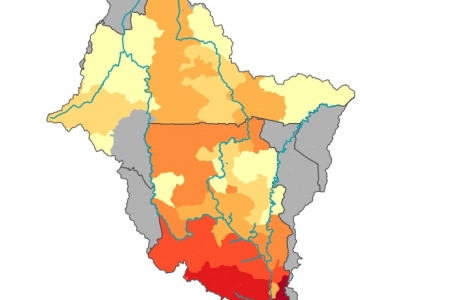Women play an increasingly greater role in agriculture. Ensuring that they have opportunities—equal to those of men—to participate in transforming agriculture is a prerequisite for sustainable intensification. Increased gender equity in agriculture is both a practical and a social justice issue: practical because women are responsible for much of the production by smallholders; and social justice because in many cases they currently do not have rights over land and water resources, nor full access to markets, and often they do not even control the crops they produce. Strategies to promote gender equity must be tailored carefully to the social and economic context.
Recommendations
- When designing and implementing a new policy or intervention, invest in studying the social, economic and agroecological context to understand gender roles, the extent and depth of gender inequality, the main barriers to women’s participation, and the opportunities for promoting equality. Use the findings to make necessary adjustments and learn lessons during the implementation process.
- Systematic participatory methodologies can effectively support diagnosis of gender roles and thus enable decision makers to achieve greater gender equity. There is a growing suite of such methods (e.g., the Gender in Irrigation Learning and Improvement Tool), which enable analysis of changing gender roles.
- In societies with very restrictive social and cultural norms that limit women’s independence and participation, and weak government commitment or capacity to promote transformation, identify those areas that are already within women’s sphere and support improving their productivity and benefits.
- In societies where social and cultural norms are less restrictive, or are changing rapidly, and where there is a strong commitment and high level of capacity, work through governments and nongovernmental organizations (NGOs) to support effective implementation of transformative gender equity policies.
- It is important to ‘think out of the box’ and identify potential livelihood opportunities both off as well as on farm, for both women and men.
Introduction
In many societies, men and women have distinctly different roles in agriculture and food production, roles that are influenced by the social and economic context. Today, urbanization and outmigration of men and youth are changing roles and responsibilities. Women are increasingly taking on greater and more varied responsibilities in farming—including irrigation, managing labor and procuring inputs. The importance of women in agricultural production is increasing in most regions.[1]
The CGIAR Research Program on Water, Land and Ecosystems (WLE) has sought to identify promising strategies for transforming inequitable social structures, norms and practices by increasing women’s access to resources, services and technologies as well as to decision making. The objective has been to enhance the ability of women to productively invest in sustainable technologies and practices and reap the benefits from these investments for themselves and their children.
Improving women’s access to resources, services and technologies
Ownership of assets is important for achieving sustainable intensification of agriculture (SIA) and poverty reduction. Women’s control of assets is associated with positive development outcomes at the household and individual levels,[2] and secure access to land and water can be important for stimulating investment in these resources and related ecosystems.
However, access to resources and services such as land, water, labor, credit, information, training and technologies is nearly always based on gender, age and social status, factors that frequently determine whether one is able to adopt and benefit from SIA practices and technologies. WLE has documented gendered and other socially constructed barriers to access land and water resources as well as strategies to open greater opportunities for poor women and men.
Access to land and water
Land is an important economic and social asset. It provides opportunities for women and men to generate income and improve the overall well-being of their families and communities. It also gives standing within communities – a point that is often ignored by development programs.[3] A detailed study of Ethiopia’s land registration program in three states concluded that registering land jointly in women’s and men’s names enhanced gender equality. However, additional effort is needed to raise awareness of opportunities to use the land more productively, facilitate access to credit and farm inputs, and strengthen men’s and women’s legal literacy.[4]
In the Eastern Gangetic Plains (Nepal’s terai, northwestern Bangladesh and northern West Bengal, India), the situation is very different: poor women have no access to land, and job opportunities in agriculture are shrinking. Few women are interested in gaining land rights because they fear breaking social ties and bonds, which are critical coping strategies. In this context, cultural norms preclude alternative coping strategies, such as participating in marketing or migrating to cities, and as a consequence, agriculture cannot be considered the sole pathway out of poverty for poor men and women.[5] [6] [7] However, even in this setting, providing women with access to water can bring nutritional benefits (access to clean water) and economic benefits, for example, through forming women’s cooperatives that own portable solar pumps.[8]
Access to water for irrigation and other domestic and productive purposes has large potential for bringing economic and nutritional benefits to women and men. However, a number of factors constrain this potential. WLE examined women’s access to motorized pumps in Zambia and Ghana.[9] [10] In principle, such individualized technologies should offer women significant production opportunities. However, in both countries, women’s access to this technology was more constrained than men’s. In any case, simply providing new technology may not sufficiently address gender inequities. A study of multiple-use water systems in Nepal, for example, found that simply providing a water supply system may reinforce existing inequalities. Therefore, it recommended a more comprehensive approach that systematically addresses social inequities.[11]
Access to services and technology
Research highlights the need to look broadly at women’s and men’s access to productive resources. While women’s access to land is not as restricted as often assumed, women often do lack access to other inputs needed for successful farming, restricting their ability to engage in agriculture.[9] [10] [12] In Ghana, for example, limiting factors for women were found to include lack of access to financial resources; limited access to water and labor; and limited access to improved processing technologies and practices, especially for shea production, an important cash crop for women.[13]
Research on climate-smart agriculture in Kenya also found that women had fewer opportunities because they had less knowledge of relevant agricultural technologies and practices, limited access to finance and low literacy rates. They were also limited by cultural norms and gender-defined labor roles.[14] Another study in northern Ghana found that while women were very interested in new crop varieties and technologies, their access to information and resources was very restricted compared to that of men.[12] These types of constraints have been highlighted in other contexts as well.[1]
By contrast, a study undertaken in Zambia and Ghana indicated that women’s and men’s adoption of water-smart technology was approximately the same and that female household members retained the economic benefits of adopting new production technology more than two-thirds of the time. The findings showed that favorable social norms and relatively greater equity in land tenure security contributed to the fairly high adoption rates of women.[15] These factors have also been shown to be important causes of high rates of technology adoption by women in southern Africa, particularly Zambia.[16]
Engaging women in decision making
Gender research on decision making traditionally examines two domains: within households and in public spaces. WLE has found that intra-household dynamics need more attention in SIA research design, data collection and analysis, as well as in development programs, to avoid ill-informed interventions. Household economic surveys usually interview the ‘head of household’, which can lead to a male-biased perspective and miss the complexity of intra-household relations.[3] [9] In-depth anthropological analysis of smallholder farming systems can contribute to improving the design of SIA interventions, making them more effective.
In addition, research often focuses on household production and plot management, while failing to examine wider social and political relationships that inform people’s production efforts.[3] WLE has explored the links between social relations, social and cultural perceptions, norms and attitudes, and the gendered power dynamics of decision-making processes. For example, a study in Ghana shows that gender narratives incorporated into policy and programs have raised awareness, but have not led to resource allocation for, or focused implementation of, initiatives to increase gender equity.[13]
Most agricultural and natural resource management policies limit their gender-sensitivity efforts to promoting disaggregated data collection and/or quotas of women participating in activities or decision-making bodies. However, collecting disaggregated data is only useful if paired with the capacity to undertake gender analysis of the data to explain its significance. Nor does gender disaggregated data address the underlying power imbalances between groups that can impact land use and production decisions and action. Rather, efforts must be made to ensure that women’s voices are heard because they may have different priorities than men, as illustrated in Box 1.
In Ethiopia, WLE has demonstrated a simple yet innovative socio-hydrological approach, using participatory three-dimensional maps to identify gendered ecosystem services. Men and women importantly emphasized different types of ecosystem services. For example, women focused their map on soils, linked to productivity and land degradation, while men mapped larger areas for grazing lands, excluded quarries or holy water sites, and mapped fewer springs and mills than women. This reflects their respective roles: feeding families (women) and engaging in income-generating activities involving livestock and eucalyptus (men).
/index.jpg?itok=ecBrUS9A)
Many studies have shown that well-intended reforms, aimed at providing women with more opportunities, often fall short because the contextual social dynamics are not well understood. For example, women’s membership in collective management organizations, such as for irrigation schemes, is frequently constrained, even where national policy supports their participation.
Constraints include rules that make membership contingent on landownership, inconvenient timing or location of meetings, and social norms that limit women’s active participation in public forums. Policy makers have tried to address this in various ways, such as by setting quotas for women in associations. But even if women are permitted to attend meetings, they are often reluctant to speak, are discouraged from speaking or see no advantage in participating, and would rather pursue more informal channels to achieve their objectives.[18] [19] [5] [20]
Finding effective interventions
Well-meaning development programs often fail to engage with the structural barriers women face in accessing irrigation and other farm resources and can at worst lead to higher levels of inequality.[5] [6] [7] Research in the Eastern Gangetic Plains, for example, found that gains in irrigated areas and increases in agricultural production largely accrue to a small minority of relatively privileged people; the vast majority is landless and remains poor. In Nepal, despite government subsidies for tube wells and pump sets, the paperwork and need for social networks to push through applications make it challenging for female-headed households to access these entitlements.
Development programs that contributed to the Green Revolution have raised overall productivity in the Eastern Gangetic Plains, through cash crops like high-yield variety paddy, tobacco and maize. However, overuse of groundwater and agrochemicals are degrading land and water resources. This has in turn impacted the poorest people, who struggle with reduced water quantity and quality as well as poor health and nutrition (particularly due to diets that include hybrid white rice which is less nutritious than traditional varieties). In addition, men migrate away from villages in search of employment elsewhere, which has increased women’s labor burden. The upside is that in the Nepali communities studied, some women are pursuing new business opportunities, such as managing tea shops and producing liquor, often using newly available microcredit.[20]
Studies of development programs, including land reforms in West Bengal and irrigation projects in Nepal, demonstrated that despite attempts to target women, women are benefitting very little if at all, and inequality is increasing. A detailed study of the impact of development projects in western Nepal arrived at the same conclusion: “The prevailing development paradigm reinforces inequitable gender structures in agrobiodiversity management, undermining adaptation to the changing climate.”[21]
How to achieve gender-equitable SIA
The gender research carried out by WLE and others clearly demonstrates that no easy solutions exist for enhancing women’s access to resources, strengthening their voices in collective decision making or increasing their benefits from intensified use of natural resources. It is crucial to base development policies and interventions on local social, economic, political and agroecological contexts. FAO[1] observes that if women farmers had access to and used the same level of resources as men, they would achieve similar crop yields. Based on its research, WLE offers the following recommendations and supporting tools to achieve greater gender equality while promoting the shift to sustainable agricultural intensification:
1: Thoroughly understand the context
Gender roles are socially constructed and subject to change over time. The new conditions created by the introduction of technologies, market penetration and male outmigration cause gender roles to change. Investment is required to study the local social, economic and agroecological context to understand how roles are gendered, the extent and depth of gender inequality, the barriers to women’s participation, and the opportunities for promoting equality. It is important to recognize the complexity of social organizations in which women and men live and in which they pursue multiple livelihood strategies. Such a thorough analysis will provide a sound basis for designing interventions aimed at helping poor women; there is no ‘one size fits all’ solution. A method developed by WLE to achieve this is the Gender Performance Indicator for Irrigation[9] (see Box 2).
GPII is an analytical tool that assesses the degree to which gender discrimination is rooted in the rural socioeconomic structure, and therefore beyond the mandate of irrigation agencies alone. Applied in a study of nine countries in Asia and Africa, it identified whether decision makers at farm, forum and higher levels are predominantly male, female or both, and the extent to which inclusion or exclusion are shaped by the irrigation agency‘s policy or are embedded in local institutional arrangements. In male-dominated systems, there is little that government agencies can do; at best, they can support the minority of women managing their own farms. In societies where women dominate agricultural production and in dual-gender systems, there are much greater opportunities to promote inclusion of women in irrigation institutions.
2: Use participatory research methodologies
An important insight emerging from WLE’s research is that enhancing positive collaboration between men and women will likely lead to better outcomes for everyone. Systematic participatory methodologies can be used to support diagnosis of changing gender roles and their implications. WLE has developed a manual for participatory gender training of farmers, which can be implemented through community-based organizations (CBOs) and NGOs. The manual, which has been successfully piloted in six villages in India and Nepal, is a guide to facilitate participatory gender training for community groups.[23]
3: Diagnose existing gender roles
There is a growing suite of useful tools for diagnosing gender roles and identifying potential intervention points. In collectively managed irrigation schemes, use of the Gender in Irrigation Learning and Improvement Tool (GILIT) can help to diagnose gender roles and increase potential for achieving greater equity[24] (Box 3). The Women’s Empowerment in Agriculture Index (WEAI) is another useful tool to capture the level of women’s empowerment and inclusion in the agriculture sector.[25] Finally, the participatory three-dimensional mapping of ecosystem services tool, demonstrated in Ethiopia, can help identify gender-disaggregated priorities.[17]
GILIT is a self-assessment scoring tool to identify which policies and operational procedures in formal irrigation schemes need adjustment to promote gender equity and to facilitate learning around gender equity[27] [24]It is organized around three themes: access to resources; participation in decision making; and access to benefits. The tool is designed for a range of stakeholders to facilitate systematic participatory assessment of the extent or lack of gender equity, the underlying causes, and potential measures to reduce gender barriers. It has been successfully pilot tested in two sites in Malawi and six in Uzbekistan.
4: Commit to structural transformations
In societies with very strong social and cultural norms restricting women’s independence and participation in agriculture, irrigation, marketing and public forums, the commitment of government policy makers as well as the capacities of local NGOs and CBOs will determine whether structural transformations are successful or not. An alternative to attempting to achieve pervasive structural transformations is to identify those areas that are already within women’s spheres and work with them to improve their productivity and benefits. Examples are home gardens, small ruminants and poultry as well as handicrafts. Where migration of men has left women managing farms, providing services directly to women may enable them to achieve higher returns.
However, where there is a strong commitment and high level of capacity of government policy makers, NGOs and CBOs, other transformative opportunities may exist in the agriculture sector. One example is farmer collectives, which directly address the structural challenges posed by small, fragmented and/or rented holdings. These schemes can be targeted at poor women and men or other marginalized groups.
5: Improve implementation of gender equity policies
In societies where local social and cultural norms are less restrictive, or are changing rapidly, it is appropriate to work with governments and NGOs to improve the implementation of gender equity policies. Examples include providing training of, and incentives for, extension workers and animators; encouraging women’s productive groups; supporting women to play real roles in public forums such as water users’ associations; providing literacy and skills training to women; promoting innovative communication channels that women can easily access; and encouraging financial and service providers to offer their products to women and even develop special products that meet women’s needs.
6: Remove sectoral blindness
In all societies, policy makers and development practitioners need to break free from their sectoral blindness and examine opportunities beyond agriculture. While agricultural growth in most cases remains the major pathway out of poverty, it may not always be the most salient one for many poor people, especially in societies with high levels of landlessness. Off-farm employment opportunities—such as utilizing non-agricultural ecological resources (e.g., medicinal plants), decentralized agro-industries or managing small businesses such as tea shops or food processing businesses—are also potentially very beneficial for rural people. In such societies, programs to support these kinds of livelihoods may be more effective for poverty reduction and achieving gender equity than increasing agricultural production.
Conclusions
Roles in agriculture are already undergoing significant transformations due to socioeconomic changes, but more change is necessary if sustainable intensification is to feed a growing global population. A major challenge will be ensuring equity, including gender equity, during and as an outcome of that process.
WLE has highlighted a number of critical aspects that must be considered. First, it is important to diagnose and fully understand the complex social, political, cultural and economic dynamics that determine and affect gender roles. To increase gender equity, it is critical to commit to reform, which is likely to require training and effective incentives, especially in enhancing positive collaboration between men and women. In societies where there is greater resistance against increased equity, supporting activities already undertaken by women may be most beneficial; other societies may readily accept or already be witnessing changing gender roles, in which case women may require additional support in their new roles.
Access to resources, such as land, labor and water, is vital and must be made part of gender and socially equitable policies. However, enabling women to participate and benefit requires change beyond access to or ownership of these resources, namely also ensuring full access to other enabling inputs such as information, credit and other services. Finally, policies and programs must think laterally and seek innovative solutions both within and outside the agriculture sector.
Acknowledgments
The team acknowledges the contributions and efforts of Douglas Merrey (independent consultant); Nicoline de Haan (currently gender lead at the International Livestock Research Institute (ILRI) and previously gender coordinator at WLE); Fraser Sugden (currently senior lecturer at University of Birmingham and previously gender coordinator at WLE); Nicole Lefore (senior project manager, IWMI); Meredith Giordano (principal researcher, IWMI); and Alexandra Evans (independent consultant) in preparing the content for this brief. We would also like to acknowledge the support of Liza Debevec (current interim gender, youth and inclusivity coordinator at WLE) and other WLE scientists in the review of the brief.
References
-
1.
FAO (Food and Agriculture Organization of the United Nations). 2017. The future of food and agriculture – Trends and challenges. Rome, Italy: Food and Agriculture Organization of the United Nations (FAO).
-
2.
Johnson, N.L.; Kovarik, C.; Meinzen-Dick, R.; Njuki, J.; Quisumbing, A. 2016. Gender, assets, and agricultural development: Lessons from eight projects. World Development 83: 295-311.
-
3.
Snyder, K.A.; Cullen, B. 2014. Implications of sustainable agricultural intensification for family farming in Africa: Anthropological perspectives. Anthropological Notebooks 20(3): 9-29.
-
4.
Yami, M.; Snyder, K.A. 2016. After all, land belongs to the state: Examining the benefits of land registration for smallholders in Ethiopia. Land Degradation and Development 27(3): 465-478.
-
5.
WLE. 2017. Poverty-gender-agriculture nexus in the northern region of Bangladesh: Challenges and opportunities. WLE Briefing Series No. 20. Colombo, Sri Lanka: CGIAR Research Program on Water, Land and Ecosystems (WLE). 4p.
-
6.
WLE. 2017. How are development projects dealing with agrarian poverty and gender issues in the North of West-Bengal, India? Colombo, Sri Lanka: CGIAR Research Program on Water, Land and Ecosystems (WLE). 4p.
-
7.
WLE. 2017. Poverty and gender in the Eastern Gangetic Plains of Nepal: Challenges and opportunities. WLE Briefing Series No. 11. Colombo, Sri Lanka: CGIAR Research Program on Water, Land and Ecosystems (WLE). 4p.
-
8.
Sugden, F. 2017. Tenant farmer collectives for sustainable intensification of agriculture: Reflection from Mithilanchal. In: Workshop on the water-livelihoods-gender nexus to advance Koshi Basin management, March 24-25, 2016, Kathmandu, Nepal. Workshop Report 2017. Kathmandu, Nepal: International Centre for Integrated Mountain Development (ICIMOD). Pp. 92-97.
-
9.
van Koppen, B.; Hope, L.; Colenbrander, W. 2013. Gender aspects of smallholder private groundwater irrigation in Ghana and Zambia. Water International 38(6): 840-851.
-
10.
Namara, R.E.; Hope, L.; Sarpong, E.O.; de Fraiture, C.; Owusu, D. 2014. Adoption patterns and constraints pertaining to small-scale water lifting technologies in Ghana. Agricultural Water Management 131: 194-203.
-
11.
Clement F.; Karki, E. 2018. When water security programmes seek to empower women – Case study from Western Nepal. In: Water security across the gender divide, eds., Frohlich, C.; Gioli, G.; Cremades, R.; Myrtinnen, H. Water Security in a New World Series. Dordrecht, Netherlands: Springer.
-
12.
Britwum, A.O.; Akorsu, A.D. 2016. Qualitative gender evaluation of agricultural intensification practices in northern Ghana. Ibadan, Nigeria: International Institute for Tropical Agriculture
-
13.
Dittoh, S.; Snyder, K.A.; Lefore, N. 2015. Gender policies and implementation in agriculture, natural resources and poverty reduction: Case study of Ghana’s Upper East Region. Colombo, Sri Lanka: International Water Management Institute (IWMI). CGIAR Research Program on Water, Land and Ecosystems (WLE). 22p. (WLE Research for Development (R4D) Learning Series 3).
-
14.
Chesterman, S.; Neely, C. (Eds.) 2015. Evidence and policy implications of climate-smart agriculture in Kenya. Copenhagen, Denmark: CGIAR Research Program on Climate Change, Agriculture and Food Security (CCAFS). (CCAFS Working Paper no. 90).
-
15.
Nicol, A.; Langan, S.; Victor, M.; Gonsalves, J. (Eds.) 2015. Water-smart agriculture in East Africa. Colombo, Sri Lanka: International Water Management Institute (IWMI). CGIAR Research Program on Water, Land and Ecosystems (WLE). Kampala, Uganda: Cooperative for Assistance and Relief Everywhere (CARE). 352p.
-
16.
van Koppen, B.; Lacombe, G.; Mwendera, E. 2015. Trends and outlook: Agricultural water management in Southern Africa. Synthesis report. USAID Project Report. Colombo, Sri Lanka: International Water Management Institute (IWMI).
-
17.
Baker, T.J.; Cullen, B.; Debevec, L.; Abebe, Y. 2015. A socio-hydrological approach for incorporating gender into biophysical models and implications for water resources research. Applied Geography 62: 325-338.
-
18.
Yami, M. 2013. Sustaining participation in irrigation systems of Ethiopia: What have we learned about water user associations? Water Policy 15(6): 961-984.
-
19.
Dewan, C.; Mukherji, A.; Buisson, M-C. 2015. Evolution of water management in coastal Bangladesh: From temporary earthen embankments to depoliticized community-managed polders. Water International 40(3): 401-416.
-
20.
Karn, S.; Sugden, F.; Sah, K.; Maharjan, J.; Sah, T.N.; Clement, F. Forthcoming. Poverty squares and gender circles: Unravelling agricultural gaps, challenges and opportunities in the Eastern Gangetic Plains of Nepal. Colombo, Sri Lanka: CGIAR Research Program on Water, Land and Ecosystems (WLE).
-
21.
Bhattarai, B.; Beilin, R.; Ford, R. 2015. Gender, agrobiodiversity, and climate change: A study of adaptation practices in the Nepal Himalayas. World Development 70: 122-132.
-
22.
van Koppen, B. 2002. A gender performance indicator for irrigation: Concepts, tools and applications. Colombo, Sri Lanka: International Water Management Institute (IWMI). 42p. (IWMI Research Report 059).
- 23.
-
24.
Lefore, N.; Weight, E.; Rubin, D. 2017. Gender in irrigation learning and improvement tool. Colombo, Sri Lanka: International Water Management Institute (IWMI). CGIAR Research Program on Water, Land and Ecosystems (WLE). 40p.
-
25.
Alkire, S.; Meinzen-Dick, R.; Peterman, A.; Quisumbing, A.; Seymour, G.; Vaz, A. 2013. The women’s empowerment in agriculture index. World Development 52: 71-91.
- 26.
-
27.
Rubin, D.; Lefore, N.; Weight, E. 2016. Gender equality and equity in irrigation scheme management: The gender in irrigation learning and improvement tool.

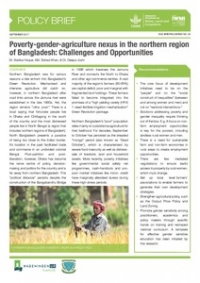
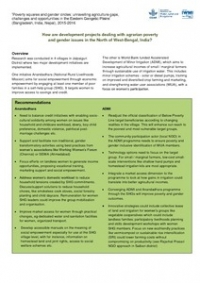
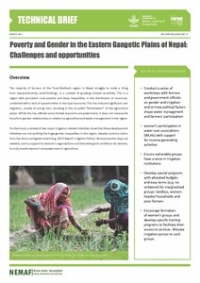
_0/index.png?itok=v9Xoe1t5)
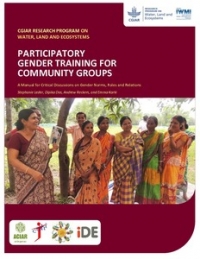
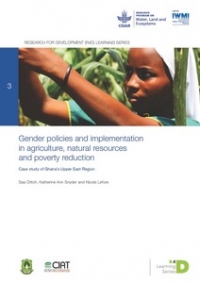
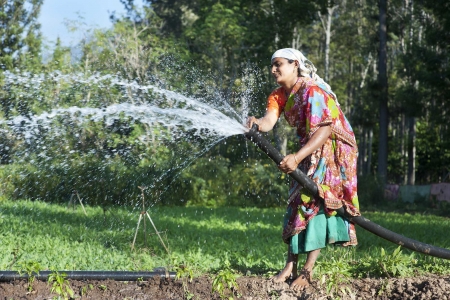

/index.jpg?itok=h9_y94HU&c=a34bc19880f857676b6acefd7701e9fb)

